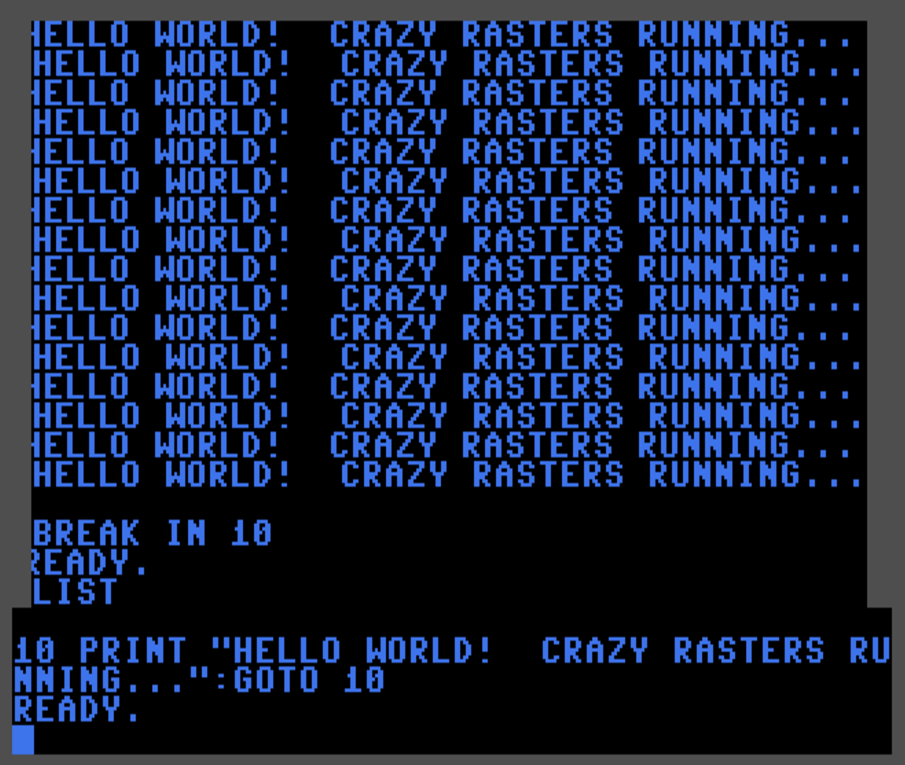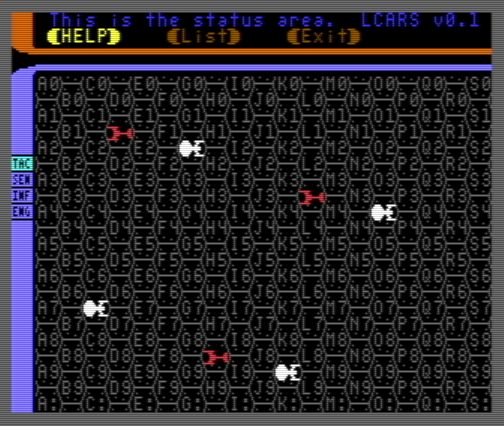Download TAFA for free
-----
April 14, 2025.
I've been wanting to do hex-map based games, and I've been trying for some considerable time to get the densest map possible, without
color clash, and without having to resort to an 8kB multicolor bitmap. The problem, of course, is that a hex map requires offsetting
the odd rows (or odd columns, but that doesn't help anything) by half a cell. As long as cells are at least 2x2, that's just simple
software logic. But I wanted to push down to 1x1 cells for density, and that means that every other row of the logical cells are not
aligned with the hardware cells, and that makes coloration very complicated and/or impossible.
Except...
I can use raster interrupts, and I can set XSCROLL to provide pixel-level offsets, as used for smooth scrolling. Games use different
XSCROLLS on different raster lines to provide parallax scrolling, so different XSCROLLs on different lines are used in many games.
If I use raster interrupts to set even/odd offset XSCROLL values for alternating lines, then the hardware cells line up with the
logical map cells, and I can use free per-character coloring to set colors for each hex cell, without any concern for neighboring cells.
The timing got a lot trickier than I was initially expecting, because we're playing around at exactly the same time that the VIC-II is
stealing ~40 cycles from the CPU so that it can load all of the information it needs to display the next 40 characters. That means that
we have to interrupt on the preceding line, then NOP our way into the right-hand border, and then immediately store the desired XSCROLL.
We can't do any kind of logic that polls the current raster line, because that's too slow and we end up inside the line before we detect
and exit the loop. This is the kind of silliness that is required at 1MHz CPU on an NTSC signal. I got it stable, and it works on PAL
just as well. Here's what it looks like:

Now, here's the fun bit. That family of raster interrupt handlers (there's one for even lines, one for odd lines, one for the "panel"
at the bottom, and one for VBlank that sets up for the top of the screen) just runs merrily along. If I exit to BASIC while they're
running, I can write new programs and run them, and get things like this:

-----
Trying to get my mojo back. Starting to feel some more "go". Not enough to tackle TAFA2 yet, but have been making my inner 18-year-old
a bit happier by hacking around on C64 programming with some of the new C cross-compilers that are available (KickC in this particular case).
The following is just graphics and layout testing. Nothing interactive at all. But still fun, and getting a little excitement about trying
to make a tactical hex combat game for my old C64 friend.

-----
A bit of silliness: I'm just a beginner with Unity, and this is just the result of one of
their tutorials (they provide all the assets), but it's kind of fun that you can build WebAsm/WebGL
builds. Not sure if the timing is reliable enough for TAFA-in-a-browser, but it's a thought...
John Lemon's Haunted Jaunt
Just to be clear, this has effectively nothing to do with TAFA, except by the barest tangent, which
is that I am at least poking around at 3D development again, however tentatively...
-----
Happy 2020!
Something I should have done long ago... Hope those of you who purchased TAFA so long ago
don't mind, but I think it's best if I just let it go free:
Share and Enjoy!
Oh, while this is a Windows-based application, it runs fine under Wine on Linux.
In case it helps:
here's a guide to installing Wine and dependencies on several common Linux distributions
Yes, this is really me. No, my site hasn't been hacked again. I've been out of touch so
long, and I just found out that people are still recommending TAFA and even digging through
archive.org to get to it. It doesn't support the newer LWO3 format, but I guess it's still
workable with old LWO2 or OBJ files. If I can't seem to get my act together for TAFA2, I can
at least let TAFA help more people.
At that link, you can find a readme, the trial setup and the activation file. Print out the
readme first, because it has the serial number you'll need. Then install the trial, then
run the activation file to unpack the full version of the program.
You may get some antivirus
warnings because I used an EXE packer, which makes heuristic antivirus scans paranoid.
You'll have to use your own judgment. I scanned and kept everything as clean as I could before
I ran the EXE packer, but ultimately it's your own call. Feel
free to run the file(s) through VirusTotal, which is probably
a good idea for anything you download from the Internet.
Hope I get to see some new work from people! My email is just 'mac' at this site.
-----
(Long overdue) Update June 6, 2019:
Maybe I'm slow, but I just now found out about Emscripten. C++ to Javascript compilation with
OpenGL and OpenAL support, and near-native speed. Has been used to port various things,
including both Unity and Unreal Engine to the web. Hmmm... So, TAFA is written in (ancient)
C++ and OpenGL.
- Its audio handling is finely tweaked Win32 multimedia code, so that would
all have to be redone (I looked briefly at OpenAL back in the day, so I'm not opposed).
- Possibly more problematic is that all of the non-3D windows are currently Win32 GDI code,
which would require a lot of rework.
- And, of course, there's the whole issue of 'files'. How would I load or save them?
Would I have to require cloud storage? Don't want to force storage on my servers... And the
resulting code would all be running locally in your browser anyway. Just have to see how
the file system inside Emscripten works with local files and browser sandboxing.
If I can recover some of my earliest morphing code via an archaeological expedition into old
hard drives, I might be able to find a simple OpenGL-only morphing codebase that I could used
to test just that core against Emscripten...
Not sure if any of this is worthwhile. I mean, it would be cool to see TAFA running under
Linux, on a Mac, and on phones/tablets. But as time marches into the future, I keep seeing
so much more advanced technology for facial animation -- automatic face tracking to match
a performer's behavior, or engines that can take text and generate both natural speech audio
and natural facial expressions. Very cool, but I can easily see how these kinds of tools
could render traditional facial animation tools irrelevant within the next few years.
And, clearly, I'm not so speedy at creating products in my 'free' time these days. But I'm
still curious. If I come up with anything, I'll make sure to put it up here for others to
play with.
-----
Hello everyone.
A recent malware scan noticed that my MediaWiki had been compromised and malware installed.
I've needed to do something with the site for a long time, anyway, so rather than just trying to
clean up and go back to my stale old style, I thought I'd take this opportunity to experiment with
some newer website techniques and systems. Hopefully, if I stick with stuff that my hosting
provider sets up, their auto-update systems will keep me protected :) In the interim, this low-key
placeholder will have to do.
I guess this also serves as a way -- not a great way, admittedly -- to show that I (and TAFA) are
still here. No real news at this time, which is part of why the website got so dusty. 1.2.2.8 still
works, though I've heard that the new Object file format in LW2018 isn't supported. Fortunately,
saving as the older style still works. Just another impetus to find a way to make something
happen with TAFA 2, I guess.
As always, thanks for your interest! I'll try not to let the garden get so weed-covered again.
Mac
P.S. Wow, has this trivial exercise reminded me how much I hate HTML. Pointed two different
mobile browsers at this page. One has unreadably small text, even after I jumped the font
size to 4 (mid-range), and if I zoom in it won't re-wrap the text. But at least the paragraph
breaks are visible. On the other, the text is nice and big, but didn't change when I set the
font size. Unfortunately, it barely shows any paragraph break at all, making the text hard to
read in a different way. Hopefully whatever browser you're using isn't choking too badly.
Heh. So, someone on a forum pointed out that I didn't have a viewport meta tag 'coz I'm out
of touch with web development. I think anyone who ever saw my old site would know that I was
never particularly "in touch" with web development. But I went and learned about viewport
meta, and it just confirms my general hatred of the web development ecosphere. The "you should
always add this meta tag" version of the viewport meta (at least, according to w3schools) just
tells your fancy new HTML5 browser to do what any dumb-as-dirt HTML1-3 browser would have done
anyway. HTML was ALWAYS supposed to wrap text to the device's viewport. It's only because
mobile browsers decided to break HTML layout to show bad web page designs shrunken to unreadability
on tiny screens. So now, unless you specifically tell them to do what they were always supposed
to do, they break your page. I get it, really. I don't even blame the mobile browser people,
particularly. Web designers have made a truly astounding number of bad web sites -- technically.
Oh, they look spectacular and do amazing things, as long as you're viewing them on a device
close enough to the one they were designed on, but they're not flexible at all. Advent of phones
has raised awareness, so now there's a whole "thing" about reactive web pages. Which is laughable,
because HTML 1 was already reactive. The designers who created it KNEW that you should focus on
content, not layout, and that it is ALWAYS the browser's job to present the information in the
best way it can. But web designers / graphic designers had to be able to control every pixel and
make web sites that work like posters, so they had to break HTML to turn it into PageMaker.
*Deep*breath* OK, got that bit of "grumpy old man" out of my system... The war is lost, on we
go with this wobbling tower of mismatched poorly designed technology...
 More silliness. Generated with the C64 Charset Logo Generator,
so I can't take any credit whatsoever...
More silliness. Generated with the C64 Charset Logo Generator,
so I can't take any credit whatsoever...


